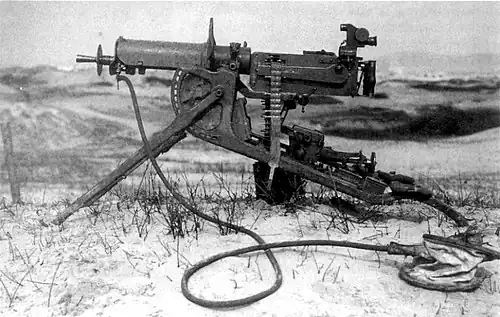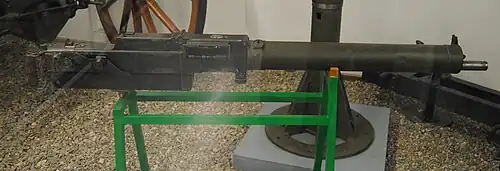MG 08
| Maschinengewehr 08 | |
|---|---|
 MG 08 deployed in sandy terrain | |
| Type | Heavy machine gun |
| Place of origin | German Empire |
| Service history | |
| In service |
|
| Used by | 25+ countries See § Users |
| Wars | See § Conflicts |
| Production history | |
| Designer | |
| Manufacturer |
|
| Developed from | Maxim MG |
| No. built | |
| Variants | See § Variants |
| Specifications | |
| Mass | 69 kg (152.12 lb) (Complete Gun)[2]
|
| Length | 1,175 mm (46.26 in)[2] |
| Barrel length | 721 mm (28.39 in) |
| Crew | 4 |
| Cartridge | |
| Action | Short recoil, toggle locked |
| Rate of fire | 450–500 rounds/min |
| Muzzle velocity |
|
| Effective firing range | 2,000 m (2,190 yd) |
| Maximum firing range |
|
| Feed system |
|
The MG 08 (German: Maschinengewehr 08, lit. 'Machine gun 08') is a heavy machine gun (HMG) which served as the standard HMG of the Imperial German Army during World War I. It was an adaptation of Hiram Maxim's 1884 Maxim gun design, and was produced in a number of variants during the war. The MG 08 also saw service during World War II in the infantry divisions of the German Army, although by the end of the war it had mostly been relegated to second-rate "fortress" units.
Designated after 1908, the year it was adopted by the Imperial German Army, the MG 08 was a development of the license-made MG 01, which was a slight development of the MG 99[3] The MG 08's rate of fire depends on the lock assembly used and averages 500 rounds per minute for the Schloss 08 and 600 rounds per minute for the Schloss 16. Additional telescopic sights were also developed and used in large quantities during World War I to enable the MG 08 to be used in long-range direct fire and indirect fire support roles.
Development and adoption
The German Rifle Commission began firing tests of the Maxim gun at Zorndorf in 1889.[4] On October 3, 1892, Kaiser Wilhelm II approved a supreme cabinet order allowing the introduction of the "8-mm Maxim machine gun into the naval artillery" for cruisers and landing parties, within the same year, Ludwig Loewe's company signed a seven-year contract with Hiram Maxim for production of the gun in Berlin.[4] The Imperial German Navy ordered Maxim guns from Loewe in 1894.[5] The Navy deployed them on the decks of ships and for use in amphibious warfare.[5] In 1896, Loewe founded a new subsidiary, the Deutsche Waffen- und Munitionsfabriken (DWM), to handle production.[5] The agreement with Maxim concluded in 1898 and DWM received orders from Austria-Hungary, Argentina, Switzerland and Russia.[5] An application for a UK patent on the sled carriage was filed by DWM in 1900.[6]
The Imperial German Army first considered using the Maxim gun as an artillery weapon[5] The German light infantry Jäger troops began trials of the gun in 1898.[5] The Guards Corps, II Corps and XVI Corps made more experiments in 1899.[7] The tests produced a recommendation of independent six-gun detachments to march with the cavalry, with the guns mounted on carriages pulled by horses.[8] Eventually, a modified Maxim was adopted as the MG 99, which was soon followed by the MG 01,[3] both were purchased in limited quantities.[8] By 1903, the German Army had 11 machine-gun detachments serving with cavalry divisions.[9]

Criticisms of the MG 01 stressed its limited mobility and inability to keep up with the cavalry.[9] The DWM and Spandau Arsenal developed the design further, decreasing weight by 7.7 kg (17 lb), adding a detachable gun shield, an option for an optical sight, and removing the wheels.[10] The result was the MG 08, which went into production at Spandau in 1908.[11] After the introduction of the MG 08, the MG 01 was mainly used by German colonial soldiers.[12][a]
Further development, training and use
The German Army observed the effectiveness of the Maxim gun in the Russo-Japanese War of 1904–1905, many of them German exports.[9] With the importance of the machine gun apparent, the Army asked for additional funding from the Reichstag to increase the supply of machine guns.[10] After criticism of the request from Socialist deputies, the Army's demand for six guns per regiment was reduced to six guns per brigade in 1907.[10] Training was regulated by the Field Service Regulations of 1908, providing the German Army six years to train with the guns before the outbreak of World War I.[13] The Army Bill of 1912 finally gave the Army its demanded six guns per regiment.[10] On 3 August 1914, soon after the outbreak of World War I, the Army had 4,411 MG 08s, along with 398 MG 01s, 18 MG 99s and two MG 09s.[14]
At the onset of World War I, Germany developed an aerodynamically refined bullet intended for machine gun use. This 12.8 grams (198 gr) full metal jacket s.S. (schweres Spitzgeschoß, "heavy spitzer bullet") boat tail projectile was loaded in the s.S. Patrone. The s.S. Patrone had an extreme range of approximately 4,700 m (5,140 yd). From its 1914 introduction the s.S. Patrone was mainly issued for aerial combat and as of 1918 in the later stages of World War I to infantry machine gunners.[15][16]
Another early-WWI improvement introduced in 1915 was a muzzle booster, a patent-protected Vickers invention, which was designated Rückstoßverstärker 08 S. Thanks to that MG 08 came up to its British and Russian analogs with their Vickers-licensed recoil boosters in its rate of fire (up from about 300-350 to 450–600 rds/min) and reliability.
Design details
The gun used 250-round fabric belts of 7.92×57mm ammunition. It was water-cooled, using a jacket around the barrel that held approximately 3.7 litres (0.98 US gal) of water. Using a separate attachment sight with range calculator for indirect fire, the MG 08 could be operated from cover.
The MG 08, like the Maxim gun, operated on the basis of short barrel recoil and a toggle lock. Once cocked and fired the MG 08 would continue firing rounds until the trigger was released or until all available ammunition was expended.

The standard iron sightline consisted of a blade front sight and a tangent rear sight with a V-notch, adjustable from 400 to 2,000 metres (437 to 2,187 yd) in 100 metres (109 yd) increments. The Zielfernrohr 12 (ZF12) was an optional 2.5× power optical sight that featured a range setting wheel graduated 400 to 2,000 metres (437 to 2,187 yd) or 400 to 2,600 metres (437 to 2,843 yd) in 100 metres (109 yd) increments. With the addition of clinometers fixed machine gun squads could set ranges of 800 to 3,475 metres (875 to 3,800 yd) and deliver plunging fire or indirect fire at more than 3,000 m (3,280 yd). This indirect firing method exploits the maximal effective range, that is defined by the maximum range of a small-arms projectile while still maintaining the minimum kinetic energy required to put unprotected personnel out of action, which is generally believed to be 15 kilogram-meters (147 J; 108 ft⋅lbf).[17] Its practical range was estimated at some 2,000 metres (2,187 yd) up to an extreme range of 3,500 metres (3,828 yd) when firing the long-range s.S. Patrone.
The MG 08 was mounted on a sled mount (German: Schlittenlafette) that was ferried between locations either on carts or else carried above men's shoulders in the manner of a stretcher.
Pre-war production was by Deutsche Waffen- und Munitionsfabriken (DWM) in Berlin and by the government Spandau arsenal (so the gun was often referred to as the Spandau MG 08). When the war began in August 1914, 4,411 MG 08s were available to battlefield units. Production at numerous factories was markedly ramped up during wartime. In 1914, some 200 MG 08s were produced each month, by 1916—once the weapon had established itself as the pre-eminent defensive battlefield weapon—the number had increased to 3,000; and in 1917 to 14,400 per month.
MG 08/15
| Maschinengewehr 08/15 | |
|---|---|
.jpg) MG 08/15 | |
| Type | Light machine gun |
| Place of origin | German Empire |
| Specifications | |
| Mass | 20.8 kg (45.86 lb) (Complete Gun)
|
| Length | 1,445 mm (56.89 in) |
| Barrel length | 721 mm (28.39 in) |
| Cartridge | |
| Action | Short recoil, toggle locked |
| Rate of fire | 450–500 rounds/min |
| Muzzle velocity |
|
| Effective firing range | 2,000 m (2,190 yd) |
| Maximum firing range |
|
| Feed system |
|
| References | [2] |
The MG 08/15 (German: Maschinengewehr 08/15, lit. 'Machine gun 08/15') was the "rather misguided attempt"[18] at a lightened and thus more portable light machine gun from the standard MG 08, produced by "stepping-down" the upper rear and lower forward corners of the original MG 08's rectangular-outline receiver and breech assembly, and reducing the cooling jacket's diameter to 89 mm (3.5 in) (compared to the MG 08's 109 mm (4.29 in))[19]. It was tested as a prototype in 1915 by a team of weapon designers under the direction of an Oberst, Friedrich von Merkatz; this became the MG 08/15.
The MG 08/15 had been designed around the concept of portability, such as the French Chauchat, which meant that the firepower of a machine gun could be taken forward conveniently by assaulting troops, and moved between positions for tactical fire support; as such, the MG 08/15 was to be manned by two trained infantrymen, a shooter and an ammo bearer. In the attack the weapon would be fired on the move (marching fire) while on the defense the team would make use of the bipod from the prone position. To accomplish that, the MG 08/15 had a short bipod rather than a heavy four-legged sled mount, plus a wooden gunstock and a pistol grip. At 18 kg (40 lb) the MG 08/15 had minimal weight savings over the MG 08, being "a cumbersome beast to use in the assault."[18] Intended to provide increased mobility of infantry automatic fire, it nevertheless remained a bulky water-cooled weapon that was quite demanding on the crews and never on par with its rivals, the Chauchat and the Lewis Gun. Accurate fire was difficult to achieve and usually in short bursts only. The fabric ammunition belts were prone to stretching and there were cartridge extraction problems when they were wet.[18]
It was first introduced in battle during the French Second Battle of the Aisne (Chemin des Dames offensive) in April 1917. Deployment in increasingly large numbers with all front line infantry regiments continued in 1917 and during the German offensives of the spring and summer of 1918.
There were other, less prominent, German machine guns in WWI that showed more promising understanding of tactical firepower; such as the air-cooled 7.92 mm Bergmann MG 15nA which weighed "a more manageable 13kg,"[18] had a bipod mount and was fed from a 200-round metal-link belt contained in an assault drum instead of fabric belts. Despite its qualities, it was overshadowed by the production volumes of the MG 08/15 and exiled to secondary fronts, being largely relegated to use in limited numbers on the Italian Front.[18] The Bergmann MG 15nA was also used by the Asien-Korps in Sinai, Mesopotamia and Palestine. Being air-cooled, the Bergmann MG 15nA's barrel would overheat after 250 rounds of sustained fire. Other light machine guns would maintain the water-cooling system, such as the Dreyse MG 10 and MG 15; with an air-cooled version produced just before the war, known as the Dreyse-Muskete or the MG 15.[20]
Despite such developments, the MG 08/15 remained by far the most common German machine gun deployed in World War I,[21] reaching a full allocation of six guns per company (72 guns per regiment) in 1918. By that time, there were four times as many MG 08/15 light machine guns than heavy MG 08 machine guns in each infantry regiment. To attain this goal, about 130,000 MG 08/15 were manufactured during World War I, most of them by the Spandau and Erfurt government arsenals. The heavy weight remained a problem though and a "futile attempt"[18] to solve this problem was a late-war air-cooled version of the MG 08/15, designated as the MG 08/18; but it was only 1 kg lighter than the MG 08/15. The MG 08/18's barrel was heavier and it could not be quickly changed; inevitably overheating was a problem. It was battlefield tested in small numbers during the last months of the war. As noted, "the Maxim Gun was not a sound basis for an LMG."[18]
Idiom
The designation 08/15 lives on as an idiom in colloquial German, nullachtfünfzehn (zero-eight-fifteen, pronounced Null-acht-fünfzehn), being used as a term to denote something totally ordinary and lacking in originality or specialness.[22]
The name of the weapon (null-acht-fünfzehn) originally became a slang term in the German Army in the Second World War. Because of the 08/15's tendency to jam, German soldiers used the name of the gun to refer to any thing that went wrong in their Army experiences.[23]
Aircraft gun development
lMG 08

A lightened air-cooled version of the original water-cooled rectangular pattern-receiver MG 08 infantry automatic ordnance, the lMG 08, was developed by the Spandau arsenal as a rigidly mounted aircraft machine gun and went into production in 1915, in single-gun mounts, for use on the E.I through the E.III production versions of the Fokker Eindecker. A lower case letter "L" beginning the prefix meant luftgekühlt (air-cooled) rather than Luft (air).[24]

The lMG 08s were later used in pairs by the time of the introduction of the Fokker D.III and Albatros D.I biplane fighters in 1916, as fixed and synchronized cowling guns firing through the propeller. The Parabellum MG14 built by DWM was a lighter (22 lbs) and quite different, air-cooled Maxim system gun with a very high rate of fire (600-700 rounds/min). It was introduced in 1915, and was, but not without serious problems on occasion (as noted by Otto Parschau), prototyped on Parschau's own A.16/15 Fokker A.III "green machine" monoplane with the Fokker Stangensteuerung gun synchronizer, received back with the synchronized Parabellum by Parschau on May 30, 1915[25] and first used in quantity as the synchronized forward-firing armament on the five examples of the Fokker M.5K/MG Eindecker production prototype aircraft, and soon afterwards served as a flexible aircraft observer's gun for rear defense.

The initial model of the air-cooled "Spandau" lMG 08 front-firing cowling machine guns had lost the stocks, grips, and bipods of the infantry MG 08s to adapt it to a fixed, forward-firing mount forward of an aircraft's cockpit, with gun synchronization allowing safe firing through a spinning propeller's arc. The 105 mm diameter cylindrical sheet metal water jacket used for the infantry's MG 08, an important support member for the barrel, was initially over-lightened with cooling slots, with fourteen rows of such slots completely surrounding and running the whole length of the jacket's circumferential sheetmetal.[26]
These alternated between seven rows of nine "oblong" slots, alternating with seven more intervening rows of eight slots and twin round holes fore and aft of the slots apiece. Because of the important physical reinforcement provided by the cooling jacket on the MG 08 series of guns, the excessive slotting of the initial model of the air-cooled lMG 08 — amounting to slightly over 50% of the total area of the cylindrical cooling jacket's original circumferential sheetmetal — rendered the gun as too fragile, to the point of making it impossible to fit the muzzle booster that the water-cooled infantry MG 08 guns could be fitted with.[26]
The later models of lMG 08 air-cooled machine gun variously "tweaked" the amount of slotting of the barrel by reducing the amount of sheet metal removed from it in minor ways through at least two or three trial formats, and eventually in the final versions produced, had the slotting omitted at the extreme ends of the cooling jacket's cylindrical member, with a 13 cm wide area of solid sheet metal at the breech end, and a 5 cm wide solid area at the muzzle end, giving the resultant gun much more rigidity. The lMG 08 also retained unchanged the rectangular rear receiver and breech assembly of the water-cooled MG 08 infantry weapon.[27]
LMG 08/15

Later, the MG 08's receiver would be lightened by being "stepped down" at its upper-rear and lower-forward corners as the more refined and lighter weight LMG 08/15 version was developed, using the same airframe mounting geometry as the earlier ordnance to allow interchangeability between the earlier lMG 08 and later LMG 08/15 models, with the still well-perforated cooling jacket reduced to a 92.5 mm diameter. Spandau Arsenal began producing the LMG08/15 in May 1916.[28] The LMG 08/15 was introduced in 1917.[27]
The lMG 08 and LMG 08/15 guns were always used on fixed-wing aircraft, as fixed forward-aimed synchronized firing ordnance initially in single mounts for Germany's 1915-16 era Fokker Eindecker and Halberstadt D.II "scout" single-seat fighters, and by 1916 in dual mounts, first appearing on the mass-produced examples of Robert Thelen's Albatros D.I and D.II fighters in late 1916, and singly on German "C-class" armed two-seat observation aircraft for synchronized forward-firing armament. The usual ammunition load for fighters was for longer, 500 round, belts, one for each gun.
A device, occasionally fitted to the rear surface of the later LMG 08/15's receiver backplate, told the pilot how much ammunition was left to fire. Later on a significant upgrade to the gun's aerial usability was the fitting of the Klingstrom device on the right side of the receiver, which allowed the gun to be cocked and loaded with one hand from the cockpit. Various cocking/charging handle styles evolved with a simplified distinctive long handled cocking/charging device finally becoming preferred late in the war.
LMG 08/15's used the 30mm "two hole" ammunition belts of the flexible Parabellum MG14 machine gun rather than the wider "three hole" belts of the MG 08/15 water-cooled infantry weapon. It is possible that these belts were used as they were a bit lighter and less bulky than the wider "three hole" ground gun belts and certainly made for standardization which would have been easier for the armorers and in addition allowed for smaller and lighter "tubes" or "chutes" that guided the empty belts into storage containers in the aircraft after firing.
It is a common misconception that the tubes or chutes coming out of the fixed mounted aviation LMG 08/15 fixed guns were for expended cartridge cases. In actuality these attachments were for guiding the empty cartridge belts into a container inside the fuselage of the aircraft so that the belts would not interfere with the operation of the aircraft. As the entire MG 08 Spandau family of German machine guns ejected their empty cartridge cases forward through a round hole in the receiver's lower forward surface, immediately under the aft end of the barrel's cylindrical cooling-jacket (as can be clearly seen on many videos), these cartridge cases were guided out of the aircraft (except on Martin Kreutzer-designed Fokker biplane fighter aircraft, and the Fokker fighters designed by Kreutzer's successor Reinhold Platz) through tubes from under the barrel to the bottom of the fuselage. With Fokker designed aircraft following the Eindecker, the cartridge cases were ejected without tubes from the receiver hole directly into open trays that guided the tumbling cartridge cases backward and sideways onto the sloped fuselage decking, which then streamed down past the cockpit on either side. These trays are clearly visible in photographs but have rarely been recognized for their purpose.
Hermann Göring, who flew both the Fokker Dr.I and Fokker D.VII was so annoyed with the case tumbling out in front of him that he had deflectors made on his aircraft to ensure the empty cartridge cases did not find their way into his cockpit. On photographs of Göring's aircraft these plates, seen only on his aircraft, are very prevalent and have even been recognized in scale models of his aircraft copying his particular planes, but even then most historians have failed to recognize their purpose. Both empty belt guides and trays were attached directly to the machine guns rather than to the aircraft. In the famous film showing Australian officers handling the LMG 08/15s from Baron von Richthofen's crashed triplane, the Fokker type belt tubes/chutes and empty cartridge trays can be clearly seen still attached to the guns.
More than 23,000 examples of the LMG 08/15 and an unknown number of the lMG 08 were produced during World War I.[27]
MG 18 TuF
| Maschinengewehr 18 | |
|---|---|
 | |
| Type | Heavy machine gun |
| Place of origin | German Empire |
| Production history | |
| Designer | Mauser |
| Designed | 1917 |
| Manufacturer | Maschinenfabrik Augsburg Nürnberg |
| Produced | 1918 |
| No. built | 50 |
| Specifications | |
| Mass | 133.7 kg (294.76 lb) (Fully Loaded)
|
| Length | 1,590 mm (62.6 in) |
| Barrel length | 960.1 mm (37.8 in)[29] |
| Crew | 6 |
| Shell | 13.2×92mmSR |
| Caliber | 13.2 mm (0.52 in) |
| Action | Short recoil, toggle locked |
| Carriage | Two-wheeled Carriage |
| Rate of fire |
|
| Muzzle velocity | 550 m/s (1,804 ft/s) |
| Effective firing range | 500 m (547 yd) horizontal |
| Maximum firing range | 6,400 m (6,999 yd) horizontal 3,000 m (9,843 ft) vertical |
| Feed system |
|
| References | [29][30] |
The MG 18 TuF (German: Maschinengewehr 18 Tank und Flieger, lit. 'Machine gun 18 tank and aircraft') is a German dual-purpose heavy machine gun that was designed to fill both anti-tank and anti-aircraft roles. Developed at the end of the First World War, it fired the same 13.2×92mmSR or tankpatrone 18 armor-piercing round later used by the Mauser 1918 T-Gewehr anti-tank rifle.[31]
History
The genesis of the MG 18 was closely linked to the appearance of the first British and French tanks on the Western Front during 1916-1917. In October 1917, the Gewehr Prüfungs Kommission (GPK), on behalf of the Ministry of War, announced a six company competition for the construction of an automatic weapon capable of firing the new 13.25 × 92mm SR ammunition designed by the Polte cartridge factory in Magdeburg.[32][33] The two finalists in this competition were Rheinmetall and Maschinenfabrik Augsburg-Nürnberg (MAN). The Rheinmetall design used a top mounted pan magazine similar to the Lewis gun, while the MAN design was a belt-fed gun. After a series of tests and modifications, the MAN design was officially adopted by the German army on August 13, 1918.[32] It was planned that some 4,000 MG 18s would be built starting in January 1919.[29] However, it is estimated that only 50 guns were actually built before the Armistice of 11 November 1918 and none were used in combat. Besides the end of the war, there were other factors which limited the number of MG 18s produced, such as lack of production capacity, cost, complexity, weight and poor mobility. The collapse of the German Empire and the prohibition of design and production of weapons imposed by the Versailles Treaty stopped any further development of the MG 18.[29]
Description
The MG 18 was essentially a scaled-up heavy machine gun, the MG 08 itself being a licensed derivative of the Maxim gun. The MG 18, like the Maxim gun, was a belt-fed, water-cooled heavy machine gun which operated on the basis of short recoil and a toggle lock. Once cocked and fired, the MG 18 would continue firing rounds until the trigger was released or until all available ammunition was expended. In the anti-tank role the gun was fed by a 75-round belt, while in the anti-aircraft role it was fed by a 30-round drum magazine.[29] Due to the weight of the gun, a two-wheeled carriage was provided and a crew of 6 men were needed to service the gun.[29]
The MG 18 was designed for the ammunition of the Mauser 1918 T-Gewehr anti-tank rifle. With its much shorter barrel, the muzzle velocity only reached 550 m/s (1,804 ft/s), compared to 785 m/s (2,575 ft/s) for the Mauser 1918; however, this was still sufficient to penetrate 20 mm (0.79 in) of face-hardened steel armor plate at 100 m (110 yd), and 15 mm (0.59 in) at 300 m (330 yd).[29]
Chinese derivative
.jpg)

Based on the commercial MG 09, in 1935, the Chinese began to produce the derivative Type 24 Heavy machine gun, which was not based solely on German drawings and introduced several improvements and new features.[34][35]
The Type 24 Heavy Machine Gun, first introduced to the National Revolutionary Army in 1935, designed to replace the original MG 08. It was the standard heavy machine gun for all Nationalists, Communists, and Warlords from 1935. They were usually made in the Hanyang Arsenal. Like the original MG 08, because of transportation difficulties, the M1917 Browning machine gun and other machine guns slowly replaced the Type 24 for the NRA after the Chinese Civil War. The PM M1910, and the SG-43 Goryunov (or Type 53/57 Machine gun) slowly replaced the Type 24 Heavy machine gun after the Chinese Civil War, but it was kept in service with the PLA, KPA and the NVA until the 1960s during the Vietnam War.[36]
The Type 24 heavy machine gun's tripod resembles the tripod of the MG 08. This gun is not able to be mounted on sledge mounts. When aiming at enemy infantry, it usually comes with a muzzle disk. When used as an anti-aircraft gun, it uses a metal pole to make the tripod higher and usually does not come with a muzzle disk. The gun's receiver is similar to the MG 08's gun body. Like the original MG 08, it needs a crew of four. The Type 24 heavy machine gun is chambered with the 7.92×57mm Mauser round, the standard Chinese military rifle cartridge of Nationalist China. After the Chinese Civil War, People's Republic of China militia and reserve units converted a number of Type 24 HMG into the 7.62×54mmR Russian cartridge. They were used for training or as filming prop, and never entered service.
Variants
- Predecessors
- MG 99 (German: Maschinengewehr 99, lit. 'Machine gun 99') — Modified Maxim machine gun made for German service in 1899. Introduced the sled mount, which remained standard in the MG 08.[8]
- MG 01 (German: Maschinengewehr 01, lit. 'Machine gun 01') — Introduced lightweight spoked wheels to the sled mount, making possible the pushing and pulling of the weapon.[8] Exported to Chile and Bulgaria.[8], with at least 400 made by 1914.
- Ground variants
- MG 08 —
- MG 08/15 —
- MG 08/18 (German: Maschinengewehr 08/18, lit. 'Machine gun 08/18') — An air-cooled variant developed at the very end of World War I as a lighter alternative to the MG 08/15 (being ~6 lb (2.72 kg) lighter).[37] Only a few hundred appeared to have been produced.[37] The MG 08/18 barrel jacket served as the basis for the MG 34 barrel shroud.[37]
- MG 09 (German: Maschinengewehr 09, lit. 'Machine gun 09') — Commercial variant of the MG 08 made by Deutsche Waffen-und Munitionsfabriken (DWM).[38]
- MG 16 (German: Maschinengewehr 16, lit. 'Machine gun 16') — An experimental, universal version of the MG 08,[19][33] which could use the bipod of the MG 08/15 or a modified tripod for the MG 08.[c] Due to production problems, it was not chosen for production.[19][33]
- Type 24 — A Chinese variant based on the MG 09 with some improvements.
- Aircraft variants
- lMG 08 —
- LMG 08/15 —
- Heavy machine gun variant
- MG 18 TuF (German: Maschinengewehr 18 Tank und Flieger, lit. 'Machine gun 18 tank and aircraft') — A variant chambered in the same 13.2×92mmSR round as the 13.2 mm (0.52 in) Mauser Anti-Tank Rifle. It was introduced in 1918, issued in very limited numbers in the near end of World War I and saw no service.[29]
Users

.svg.png) Austria-Hungary[5]
Austria-Hungary[5] Argentina[5]
Argentina[5].svg.png) Belgium[39]
Belgium[39] Brazil
Brazil Bulgaria — At least two MG 01s were delivered and used during the Balkan Wars.[8] MG 08 were supplied before the Balkan Wars and during World War I.[40] After World War I, some were retained, both officially and as hidden supplies.
Bulgaria — At least two MG 01s were delivered and used during the Balkan Wars.[8] MG 08 were supplied before the Balkan Wars and during World War I.[40] After World War I, some were retained, both officially and as hidden supplies. Chile — Despite the cheaper Hotchkiss machine gun already in service, the MG 01 was adopted as the ametralladora Maxim modello 1902 (in 7mm Mauser)[8] on the orders of Emil Körner who was affiliated with DWM.[41]
Chile — Despite the cheaper Hotchkiss machine gun already in service, the MG 01 was adopted as the ametralladora Maxim modello 1902 (in 7mm Mauser)[8] on the orders of Emil Körner who was affiliated with DWM.[41] China — Made under license as the Type 24 heavy machine gun.[34] Imported MG 08/15 machine guns also used during Second Sino-Japanese War.[35]
China — Made under license as the Type 24 heavy machine gun.[34] Imported MG 08/15 machine guns also used during Second Sino-Japanese War.[35] Czechoslovakia — The MG 08/15 was in use after independence[42]
Czechoslovakia — The MG 08/15 was in use after independence[42] Finland — The MG 08 (designated 7.92 KK 08) used as late as the Continuation War (mostly with coastal troop).[43] The MG 08/15 and MG 08/18 (designated 7.92 PK 08-15 and 7.92 PK 08-18 respectively) were used until 1931, when they were sold off.[44]
Finland — The MG 08 (designated 7.92 KK 08) used as late as the Continuation War (mostly with coastal troop).[43] The MG 08/15 and MG 08/18 (designated 7.92 PK 08-15 and 7.92 PK 08-18 respectively) were used until 1931, when they were sold off.[44] France — MG 08 and 08/15 versions were captured and used by French forces in WW1 and afterwards.[45]
France — MG 08 and 08/15 versions were captured and used by French forces in WW1 and afterwards.[45].svg.png) German Empire — Used by the Kaiserliche Marine and Deutsches Heer between 1901–1919.[5][46] By the start of World War I, almost all of the MG 01s and other machine guns considered obsolete had been relegated to machine gun detachments in Germany's colonial possessions where they had started to be replaced by the MG 08s.
German Empire — Used by the Kaiserliche Marine and Deutsches Heer between 1901–1919.[5][46] By the start of World War I, almost all of the MG 01s and other machine guns considered obsolete had been relegated to machine gun detachments in Germany's colonial possessions where they had started to be replaced by the MG 08s..svg.png) Germany[39]
Germany[39] Indonesia — Used Chinese Type 24.[36]
Indonesia — Used Chinese Type 24.[36] Latvia — At least 11 light-weight MG 08s used by the Latvian Army (by April 1936)[47]
Latvia — At least 11 light-weight MG 08s used by the Latvian Army (by April 1936)[47] Lithuania[48] — About 800 MG 08 (7,92 mm sunkusis kulkosvaidis 08 m.) and 520 MG 08/15 (7,92 mm lengvasis kulkosvaidis 08/15 m.). Some MG 08 were modernized for anti-aircraft defense.
Lithuania[48] — About 800 MG 08 (7,92 mm sunkusis kulkosvaidis 08 m.) and 520 MG 08/15 (7,92 mm lengvasis kulkosvaidis 08/15 m.). Some MG 08 were modernized for anti-aircraft defense. Netherlands — Ex-German MG 08s confiscated at the end of WWI entered Dutch service in 1925 in the light anti-aircraft role, with the designation Spandau M.25.[49][50]
Netherlands — Ex-German MG 08s confiscated at the end of WWI entered Dutch service in 1925 in the light anti-aircraft role, with the designation Spandau M.25.[49][50]

.svg.png) Ottoman Empire[51]
Ottoman Empire[51] People's Republic of China — Used Type 24 guns (converted to 7.62×54mmR).[36]
People's Republic of China — Used Type 24 guns (converted to 7.62×54mmR).[36].svg.png) Poland — Between 1918–1944, up to 5,964 MG 08 (ckm wz.08) and 7,775 MG 08/15 (lkm wz.08/15) were used.[52]
Poland — Between 1918–1944, up to 5,964 MG 08 (ckm wz.08) and 7,775 MG 08/15 (lkm wz.08/15) were used.[52] Malaysia — Used Chinese-made Type 24.[36]
Malaysia — Used Chinese-made Type 24.[36] Manchukuo — Used Chinese-made Type 24s[53]
Manchukuo — Used Chinese-made Type 24s[53] Romania — Commercial MG 09 variant marked as Model 1910.[33]
Romania — Commercial MG 09 variant marked as Model 1910.[33] Russian Empire[5]
Russian Empire[5].svg.png) Switzerland[5]
Switzerland[5].svg.png) Spanish Republic[54]
Spanish Republic[54] United Kingdom — At least 1 MG 01 captured from the Germans and put into service during World War I.[55]
United Kingdom — At least 1 MG 01 captured from the Germans and put into service during World War I.[55] Vietnam — The Viet Minh used Chinese Type 24 during the First Indochina War,[56] as did the Viet Cong during the Vietnam War.[57]
Vietnam — The Viet Minh used Chinese Type 24 during the First Indochina War,[56] as did the Viet Cong during the Vietnam War.[57].svg.png) Yugoslav Partisans[58]
Yugoslav Partisans[58]
Surviving examples
MG 01
There are only 2 known surviving examples of the MG 01:
- No. 206 — Produced in 1902, located in the Bayerisches Armeemuseum in Ingolstadt, Bavaria. It belonged to the III. Bataillon 3. Infanterie Regiment, 1. Maschinengewehr Abteilung, located in Augsburg, Bavaria.[59]
- No. 626 — Produced in 1907 in Berlin, located in the Royal Museum of the Armed Forces and Military History in Brussels, Belgium. It was most likely one of the MG 01s delivered to the navy, later during World War I, it was captured by the British Empire.[55]
Conflicts

- 1900 – 1920s
- Herero Wars (1904–1908)[e]
- Mexican Revolution
- Xinhai Revolution
- Balkan Wars[e]
See also
Weapons of comparable role, performance and era
- Bergmann MG 15nA machine gun – (German Empire)
- M1917 Browning machine gun – (United States)
- Kjellman machine gun – (Sweden)
- Marlin M1917 & M1918 machine guns – (United States)
- PM M1910 – (Russian Empire, Soviet Union)
- Schwarzlose MG M.07/12 – (Austria–Hungary)
- Vickers machine gun – (United Kingdom of Great Britain and Ireland)
Notes
- ^ During World War I, it was used by the East and South West African Schutztruppe where it was commonly mounted on tripods and artillery carriages.
- ^ The 100-round cloth belt could be loaded in a metal Patronenkasten 16 belt carrier drum
- ^ The tripod was later issued as the Dreifuss 16 which required an adapter for mounting the MG 08.[19][33]
- ^ Notice the MG 08s are mounted on tripods instead of sledge mounts that were common to the MG 08.
- ^ a b c d Wars that included the use of the MG 01.[8]
- ^ Including the aftermath of World War I.
- ^ In the Kiautschou Bay Leased Territory, it was used by the machine gun company of the III. Seebataillon.[12]
References
Citations
- ^ a b Goldsmith 1989, p. 169.
- ^ a b c MG 08 (modernfirearms.net).
- ^ a b MG 99 and MG 01 (german1914.com).
- ^ a b Bull 2016, p. 10.
- ^ a b c d e f g h i j k Bull 2016, p. 11.
- ^ GB 190021630A
- ^ Bull 2016, pp. 11–12.
- ^ a b c d e f g h Bull 2016, p. 12.
- ^ a b c Bull 2016, p. 13.
- ^ a b c d Bull 2016, p. 14.
- ^ Bull 2016, p. 15.
- ^ a b Dale 2022.
- ^ Bull 2016, p. 44.
- ^ Bull 2016, p. 28.
- ^ Die Patrone 7.92mm (8x57)
- ^ 20th Century German Military Arms and Ammo
- ^ Kjellgren, G. L. M. "The Practical Range of Small Arms" (PDF). The American Rifleman. pp. 40–44. Archived (PDF) from the original on 5 March 2015.
- ^ a b c d e f g McNab (2012) p.9
- ^ a b c d Musgrave 1999.
- ^ McNab 2012, pp. 10.
- ^ Dolf Goldsmith, 1989
- ^ ""null-acht-fünfzehn"", das Digitale Wörterbuch der deutschen Sprache, archived from the original on 2018-05-11
- ^ Houlihan, Thomas Kriegsprache: Glossary of World War II German Military-and Period-Specific Words, Phrases and Abbreviations for Historians, Researchers and Hobbyists. Maps at War, Lake Orion, Michigan, 2009. ISBN 978-0-578-01849-2
- ^ Woodman 1997, pp. 2–3.
- ^ VanWyngarden 2006, p. 9.
- ^ a b Woodman 1997, p. 2.
- ^ a b c Woodman 1997, pp. 3–5.
- ^ LMG 08/15 (Forgotten Weapons).
- ^ a b c d e f g h MG 18 TuF (smallarmsreview.com).
- ^ MG 18 TuF (modernfirearms.net).
- ^ Rifle vs Tank (Tank Archives).
- ^ a b MG 18 TuF (ww1.milua.org).
- ^ a b c d e German Maxim MG (cruffler.com).
- ^ a b Jowett 2005, p. 19.
- ^ a b Shih 2011, pp. 299–300.
- ^ a b c d Bull 2016, p. 6.
- ^ a b c MG 08/18 (Forgotten Weapons).
- ^ MG 09 (iwm.org.uk).
- ^ a b Bull 2016, p. 65.
- ^ Vachkov 2018, pp. 115–119.
- ^ Stoker & Grant 2003, p. 67.
- ^ "Czechoslovak Weapons of World War II: part 1: Czechoslovakia was well-armed and fortified before World War II, but appeasers in Britain and France pulled the rug out, making "Munich" a synonym for betrayal. - Free Online Library". www.thefreelibrary.com. Retrieved 2022-12-30.
- ^ Maxim MG 08 (jaegerplatoon.net).
- ^ Maxim M/08-15 (jaegerplatoon.net).
- ^ "French soldiers use captured German Maschinengewehr 08 machine guns".
- ^ Buchholz 2019, pp. 22–23, 42–43.
- ^ Dambītis 2016, p. 225.
- ^ Andersons 2001, pp. 113–153.
- ^ Dutch machineguns (waroverholland.nl).
- ^ Spandau M.25 (grebbeberg.nl).
- ^ "Ottoman machine gunners". New Zealand History. Retrieved 22 February 2023.
- ^ Konstankiewicz 1986, pp. 106, 119.
- ^ Jowett 2004, p. 15.
- ^ a b de Quesada 2015, p. 38.
- ^ a b Buchholz & Brüggen 2019, pp. 22–23.
- ^ Ezell 1988, p. 34.
- ^ Smith 1969, p. 719.
- ^ Vukšić 2003, p. 60.
- ^ Buchholz & Brüggen 2019, pp. 42–43.
Main sources
- Books
- Smith, Joseph E. (1969). Small Arms of the World (11 ed.). Harrisburg, Pennsylvania: The Stackpole Company. ISBN 9780811715669.
- Konstankiewicz, Andrzej (1986). Broń strzelecka Wojska Polskiego 1918-39 [Small arms of the Polish Army 1918-39] (in Polish). MON, Warsaw: Wydawn. Ministerstwa Obrony Narodowej. ISBN 83-11-07266-3.
- Ezell, Edward Clinton (1988). Personal firepower. The Illustrated history of the Vietnam War 15. Bantam Books. ISBN 9780553345490. OCLC 1036801376.
- Goldsmith, Dolf L. (1989). The Devil's Paintbrush: Sir Hiram Maxim's Gun. Collector Grade Publications. ISBN 0-88935-282-8.
- Bruce, Robert (1997). Machine Guns of World War I. Windrow and Greene Ltd. ISBN 1-85915-078-0.
- Woodman, Harry (1997). Spandau Guns, Windsock Mini-Datafile No.10. Albatros Publications Ltd. ISBN 0-948414-90-1.
- Musgrave, Daniel D. (September 8, 1999) [1992]. German Machineguns [2nd Edition]. Alexandria, Virginia: Ironside Internation Publishers Inc. ISBN 9780935554069.
- Vukšić, Velimir (July 2003). Tito's partisans 1941–45. Warrior 73. Osprey Publishing. ISBN 978-1-84176-675-1.
- Stoker, Donald J.; Grant, Jonathan (30 August 2003). Girding for Battle: The Arms Trade in a Global Perspective, 1815-1940. Greenwood Publishing Group. ISBN 978-0-275-97339-1.
- Jowett, Philip S. (2004). Rays of the rising sun : armed forces of Japan's Asian allies, 1931-45. Vol. 1, China & Manchukuo. Helion. ISBN 9781906033781.
- Jowett, Philip S. (July 10, 2005). The Chinese Army 1937–49: World War II and Civil War. Men-at-Arms 424. Osprey Publishing. ISBN 9781841769042.
- Kowner, Rotem (January 26, 2006). Historical dictionary of the Russo-Japanese War (Hardcover). The University of Michigan: Bloomsbury Academic. ISBN 978-0-8108-4927-3.
{{cite book}}: CS1 maint: year (link) - VanWyngarden, Greg (October 31, 2006). Early German Aces of World War 1. Aircraft of the Aces #73. Botley, Oxford UK & New York City, United States: Osprey Publishing. ISBN 978-1-84176-997-4.
- Shih, Bin (2011). China's Small Arms of the 2nd Sino-Japanese War (1937-1945) (2021 ed.). ISBN 979-8473557848.
- McNab, Chris (2012). MG 34 and MG 42 Machine Guns. Weapon No. 21. Oxford, UK: Osprey Publishing. ISBN 978-1-78200-309-0. OCLC 838150388.
- de Quesada, Alejandro (January 20, 2015). The Spanish Civil War 1936–39 (2): Republican Forces. Men-at-Arms 498. Osprey Publishing. ISBN 9781782007852.
- Bull, Stephen (2016). German Machine Guns of World War I: MG 08 and MG 08/15. Weapon No. 47. Oxford, UK: Osprey Publishing. ISBN 978-1-4728-1516-3.
- Vachkov, Alexander (2018). Поръчки на въоръжение от DEUTSCHE WAFFEN –UND MUNITIONSFABRIKEN AG през първата световна война, в: Сборник с доклади от научната конференция „България – Германия. Първата световна война. Поуки за бъдещето“ [Arms Supplies from DEUTSCHE WAFFEN – UND MUNITIONSFABRIKEN AG during the First World War in: Proceedings of the science conference "Bulgaria-Germany. First World War. Lessons Learned"] (in Bulgarian). Varna: Nicola Vaptsarov Naval Academy. ISBN 978-619-7428-27-8.
- Buchholz, Frank; Brüggen, Thomas (2019). Wirtgen, Rolf (ed.). Deutsche Maschinengewehre: Entwicklung, Taktik und Einsatz von 1892 bis 1918 [German Machine Guns: Development, Tactics, and Use from 1892 to 1918] (in German). Vienna, Austria: Verlag Militaria. ISBN 978-3-902526-95-3.
- Others
- Dambītis, Kārlis (2016). Latvijas armijas artilērija 1919.-1940.g.: Vieta bruņotajos spēkos, struktūra un uzdevumi [Artillery of the Latvian Army 1919-1940: Place in the Armed Forces, Structure and Tasks] (PhD thesis) (in Latvian). University of Latvia.
Secondary sources
- With authors
- Andersons, Edgars (2001). "The military situation in the Baltic States" (PDF). Baltic Defence Review. 2001 (6). Archived from the original (PDF) on January 24, 2019. Retrieved January 23, 2019.
- Firestone, Adam C. (February 2002). "Historic Firearm of the Month, February 2002". cruffler.com. Retrieved April 14, 2025.
- McCollum, Ian (October 25, 2018). "The MG 08/15 Updated Between the Wars". forgottenweapons.com. Forgotten Weapons. Retrieved June 6, 2024.
- Buchholz, Frank (November 1, 2019). "The beginning with Sir Hiram Maxim's guns: MG 99 and MG 01". german1914.com. Colonel J's. Retrieved April 24, 2022.
- Buchholz, Frank (November 8, 2019). "The standard machine-gun of the German army: MG 08". german1914.com. Colonel J's. Retrieved April 24, 2022.
- Dale, Chris (April 22, 2022). "Machine Guns of the Schutztruppe and Overseas Forces". germancolonialuniforms.co.uk. German Colonial Uniforms. Retrieved April 24, 2022.
- McCollum, Ian (June 7, 2023). "Last Gasp of the German Maxim: the Air-Cooled MG 08/18". forgottenweapons.com. Forgotten Weapons. Retrieved June 6, 2024.
- McCollum, Ian (April 24, 2024). "Maxims in the Skies: the German LMG 08/15". forgottenweapons.com. Forgotten Weapons. Retrieved June 6, 2024.
- Popenker, Maxim (2025). "MG 08, MG 08/15, MG 08/18". modernfirearms.net. Retrieved July 7, 2025.
- Popenker, Maxim (2025). "TuF (Tank-und-Flieger) heavy machine gun (Germany)". modernfirearms.net. Retrieved July 7, 2025.
- Ulanov, Andrey (February 10, 2021). Samsonov, Peter (ed.). "Rifle vs Tank". tankarchives.ca. Tank Archives.
- Without authors
- "7,62 mm Maxim m/1905 and m/1910 (M/09-09) | MACHINEGUNS PART 1: 7,62 mm Maxim machineguns". www.jaegerplatoon.net. Finland. Retrieved June 6, 2024.
- "7,92 mm Maxim MG 08 | MACHINEGUNS PART 2: Other machineguns". jaegerplatoon.net. Finland. Retrieved July 7, 2025.
- "7,92 mm light machine guns M/08-15 and M/08-18 | MACHINEGUNS PART 2: Other machineguns". jaegerplatoon.net. Finland. Retrieved July 7, 2025.
- "Dutch machineguns [War over Holland - May 1940: the Dutch struggle]". www.waroverholland.nl. Archived from the original on December 3, 2013. Retrieved July 7, 2020.
- "Spandau M.25". grebbeberg.nl (in Dutch). Retrieved May 5, 2025.
- "Germany's Ultra Rare MG18 - the 13mm Maxim T.U.F.-MG "Tank und Fleigerabwehr" Machine Gun of WWI - Small Arms Review". smallarmsreview.com. November 23, 2023.
- "MG 09". iwm.org.uk. Imperial War Museum.
The MG 09 was a commercial development of the German MG 08 Maxim by the Berlin arms manufacturer Deutsche Waffen-und Munitionsfabriken. This example was purchased by Bulgaria, and displays prominently the Bulgarian coat of arms and royal cipher. It was captured during the Salonika campaign by D Company, 2nd Cameron Highlanders. On 14 October 1917, the gun was holding up the left flank of an attack on Homondos village. Lieutenant R MacIntyre, a Lovat's Scout attached to D Coy, gathered a group of men and captured it; an action which earned him a Military Cross.
- "Противотанковый крупнокалиберный пулемет MG 18 TUF" [Anti-tank heavy machine gun MG 18 TUF]. ww1.milua.org (in Russian). Archived from the original on January 3, 2013. Retrieved May 19, 2018.
- "The Royal Erfurt Arsenal". hlebooks.com. Retrieved May 19, 2025.
- "13.2mm TuF Anti-Tank Round". historicalfirearms.info. Historical Firearms. Retrieved May 19, 2025.
External links
- "The beginning with Sir Hiram Maxim's guns: MG 99 and MG 01". german1914.com.
- "The standard machine-gun of the German army: MG 08". german1914.com.
- "Machine Guns of the Schutztruppe and Overseas Forces". germancolonialuniforms.co.uk.
- "Mitrailleuse MG 08" [MG 08 machine gun]. mitrailleuse.fr (in French).
- YouTube animation showing mechanism of MG 08 machine gun
- "Противотанковый крупнокалиберный пулемет MG 18 TUF" [Anti-tank heavy machine gun MG 18 TUF]. ww1.milua.org (in Russian). Archived from the original on January 3, 2013.
